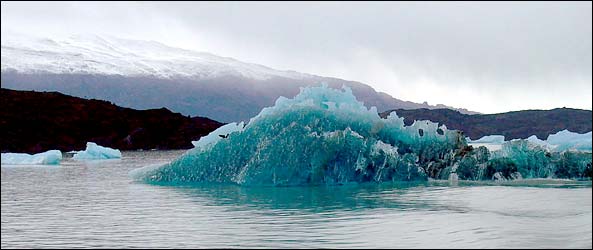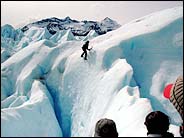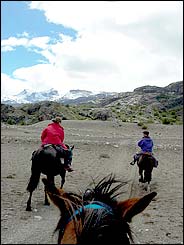
January 4, 2004
Homage to Patagonia
| |
![]() S
we boarded our plane in Buenos Aires, we all agreed that the newspaper
headlines had been quite alarming: the Patagonian ice fields, the
papers said, melted twice as fast from 1995 to 2000 as they did from
1975 to 2000, as a result of global warming and lower snowfall at the
bottom of the world.
S
we boarded our plane in Buenos Aires, we all agreed that the newspaper
headlines had been quite alarming: the Patagonian ice fields, the
papers said, melted twice as fast from 1995 to 2000 as they did from
1975 to 2000, as a result of global warming and lower snowfall at the
bottom of the world.
So what awaited us - three well-traveled friends from three countries - as we strode out of the airport into the bracing winds of El Calafate, the tiny Patagonian town of 6,500 that was to be our base for the next four days?
Could we expect to see icebergs crumble before our very eyes? Would the glaciers' pristine ice-blue whiteness have faded? Would crevasses open below our feet as we trekked over the packed snow?
 |
| Icebergs that have calved from the Upsala glacier into Lago Argentino. |
The two ice fields in question, in Argentina at South America's southernmost tip, cover 6,600 square miles and include no fewer than 63 glaciers, some with spectacular walls of ice more than 300 feet high. Even at the present - admittedly alarming - melting rate of 10 cubic miles of ice a year, the glaciers look set to remain a major tourist attraction for years to come.
But therein lies a problem.
In a globalized world where getting away, really away, is becoming increasingly difficult, Patagonia has long been a byword for splendid isolation, the place to go for vast, empty spaces, geographical remoteness and rugged, untouched natural beauty.
It still is. But since Argentina's economic collapse lopped two-thirds off the value of the peso, it is no secret that Argentina has become a bargain and Patagonia is nowhere nearly as expensive to visit as it once was.
Our four-day package leaving from Buenos Aires included shared accommodation at the upscale country inn Kau Yatún, two full-day excursions to separate glaciers, and hiking or horseback riding on a sheep ranch, and cost just over $550 a person, a third of what it would have cost two years ago.
That means that the glaciers of El Calafate and of Ushuaia, the world's southernmost city, on the Beagle Channel navigated by Charles Darwin, and the whale-spotters' paradise Puerto Madryn, are attracting tourists by the thousands. Going exactly where you want, when you want and getting into the hotel you want can be a challenge.
The tour operator had told us, for example, that trekking on the Perito Moreno glacier was a full-day excursion and could not be worked into our tight schedule. But all it took was a quick stroll to Sunny Tours, one of the dozens of local operators on El Calafate's main street, to join a half-day ice-hike with eight other tourists and two guides. It cost $75 each, and at the end of our four days we agreed it had been the highlight of the trip and well worth the money.
The drive from El Calafate through the steppe and forests of Glaciers National Park to Shadow Bay, where we were to catch a ferry to the glacier, took just over an hour. Just before Shadow Bay, where the glacier wall rears into sight, a couple of tour buses parked and spewed out a group of about 30 Italian and Dutch tourists eager to make the most of the photo opportunity.
Grumbling at this "mass tourism," we independent travelers - Gabi is a banker from Austria, França a photographer from Portugal and I am a journalist based in Brazil - reflected that tour buses looked decidedly incongruous against such a pristine backdrop and that the authorities might be better advised to allow only more discreet minibuses inside the park.
A few minutes later down at the jetty, we joined the Italians and Dutch on board the Perito Moreno ferry that was to take us across the Rico channel of Lago Argentino, Argentina's largest lake, for our hike.
We might have been scathing about snap-happy tourists moments earlier, but once the boat began its 20-minute voyage along the 180-foot high glacier wall - keeping a distance of about 900 feet, out of range of the ice shrapnel that flies in all directions when blocks of ice break off with a loud crack and tumble into the icy water - we reached for our cameras like everybody else.
The majestic wall of ice towered above the slate-green water. With the breeze chilling our ears we watched, enchanted, as the pale sun played peekaboo from behind the fast-moving clouds, sending ever-changing shapes racing like giant shadow boxers across the sheer glacier wall.
Landing at a tiny wooden lodge, the guides' base, our group filed through a forest of indigenous beech trees for about 20 minutes, gasping occasionally as the white of the glacier appeared framed in clearings of lush green vegetation.
At the bottom of the glacier, seated on wooden benches and huge boulders from the moraine that the ice pushes along as effortlessly as pebbles, we were kitted out with spikes - metal snowshoes with jagged soles - by our guides, Mariano Agriello and Lucía. Both trained mountaineers, they gave the group concise instructions how to climb and descend the icy slope, basically by leaning toward the slope, bending the knees and/or ankles and keeping all the spikes impaled in the ice.
Though this made everyone walk like the Incredible Hulk, it
was not
as difficult as we had imagined, and soon we were scaling the slopes,
passing turquoise lagoons of deliciously fresh water, which we were
encouraged to drink. Waiting every so often for Mariano and
Lucía to
hack a pathway for us with their ice picks, we climbed 100 feet or so
to the glacier's lowest peaks, from which we could peer over the
apparently endless ice field.
 |
| Lucía Saquero, a mountain guide, demonstrates ice climbing on the Perito Moreno glacier. |
After two hours we climbed down again and stopped at a wooden bunker encased in the ice, from which Mariano produced a bottle of 12-year-old malt whisky, which he served after cramming our glasses with glacier ice.
"This is probably the first time you have drunk whisky on the rocks where the ice is older than the whisky," he said, and then enlightened us: it had taken the ice at this edge of the glacier 300 years to reach here from its source, 20 miles away.
Although most glaciers in Patagonia have been in retreat for almost 100 years, Perito Moreno is stable. It replaces the amount of ice each year that is lost by icebergs' breaking off and floating down Lago Argentino.
Formed by a high pressure zone over the Pacific Ocean to the west of Chile, reacting with lows over the Atlantic east of Argentina to produce snow that is compacted to ice on the Andes, Patagonia's glaciers crawl inexorably toward the sea or its myriad lakes.
The next day we sailed down another arm of the lake toward the
massive Upsala glacier, aboard Upsala Explorer, a comfortable coastal
cruiser that wends its way through craggy icebergs to the glacier and
deposits its passengers for an afternoon's hiking or horseback riding
on Estancia Cristina, a sheep ranch founded in 1914 by a family of
British immigrants, the Masterses.
 |
| At Estancia Cristina, a sheep farm. |
As I was one of only two passengers to opt for the horseback ride, it was here, in the deserted, windswept valleys dotted with heather, murmuring brooks and silvery lagoons, that I found the Patagonia I had imagined. We rode large but fairly docile horses for two hours before stopping for a picnic in the lee of a rocky slope overlooking the lake where the Masters family used to go fishing. Upon returning - another two hours - we joined the rest of the group who, after a brief hike, had been feasting at the old ranch house on roast Patagonian lamb and chocolate mousse. It was so good they saved no mousse for us.
The food at our hotel, the Kau Yatún, was also hearty, with a sprawling breakfast buffet served in the informal setting of a wood-paneled dining room-cum-bar. Though we all liked the Kau Yatún's informal country style, we would have preferred staying at the Hostería Los Notros, the only hotel within the national park. A wooden lodge on a gentle slope opposite Perito Moreno, Los Notros has a main lodge and two separate wings of 32 rooms each with a stunning view over the glacier. Unfortunately there were no vacancies on the nights we were in Patagonia, and for the dates there were vacancies we could get no flights.
After a look around, I would say the lodge is a must for recluses who like their luxury. There are no newspapers allowed, and no telephones or television in the rooms, though there are huge Jacuzzi tubs with views. A nod to modernity (and possible emergencies) is the solitary iMac that sits in the rustic, wood-beamed bar area. The nearest shop is in El Calafate, 25 miles away.
"Being discovered is a two-edged sword," said Lelia Cataldi, head of guest relations. "We try to point our guests toward more exclusive activities, private glacier trekking, horseback riding far up the mountain, visiting the glacier at dawn or dusk before the buses arrive from Calafate or after they leave."
In Calafate, nonetheless, we didn't suffer. At La Vaca Atada, a small, cozy restaurant on the small main street with the big name of Avenida Libertador General San Martín, we enjoyed a truly excellent dinner of cold cuts, followed by locally caught trout with rosemary potatoes, accompanied by champagne and a hearty Malbec red wine, for less than $15 a head. As at most other restaurants in town at peak hours, there was a 30-minute wait. Patagonia clearly is not as remote as it once was.
Visitor Information
After Argentina's economic crisis, Patagonia has become something of a bargain. For a trip of a week or 10 days, combining two or more destinations is probably a good idea. In El Calafate, one can visit spectacular glaciers, go trekking or horseback riding on a sheep ranch, or drive off road in four-wheel-drive vehicles to enjoy breathtaking views of Mount Fitzroy, over 11,000 feet of sheer granite and ice.
For splendid isolation, one can stay a couple of nights at Los Notros, overlooking the Perito Moreno glacier. In Ushuaia, the world's southernmost town, there is an Alcatraz-like former jail, hiking, mountain biking and kayaking, and boat trips along the Beagle Channel, navigated by Darwin. Whales and penguins can be spotted near Puerto Madryn.
Tour Operators and Agencies
Though tours can be booked in advance, one can be more flexible using local operators on arrival in order to mix and match excursions on a day-to-day basis.
Our four-day package, which cost just over $550 a person, was arranged by Patagonia-argentina.com, Libertad 956, Local 15B, 1012 Buenos Aires, phone and fax (54-11) 4815-2952, www.patagonia-argentina.com.
Ranch vacations can be arranged by Estancias de Santa Cruz, Suipacha 1120, 1008 Buenos Aires, phone and fax (54-11) 4325-3098, www.estanciassantacruz.com.
A friendly and helpful outfit that arranged glacier trekking was Hielo y Aventura, Avenida del Libertador 935, 9405 El Calafate, (54-2902) 492-094, fax (54-2902) 491-053; www.hieloyaventura.com.
Sunny Viajes y Turismo, Avenida del Libertador 1315, 9405 El Calafate, (54-2902) 492-563, which was most helpful, arranged our half-day ice hike for $75.
Hotels
Hostería Los Notros, Ruta Provincial 11, 9405 El Calafate, (54-2902) 499-511/10, www.losnotros.com, is a 32-room luxury country lodge overlooking the Perito Moreno glacier. Full board - necessary because of its remoteness - with transfers to and from the airport and an expedition to the glacier starts at $400 a night per person for a double. The hotel is open from September to May, and is generally booked three months in advance.
Kau Yatún, Estancia 25 de Mayo, 9405 El Calafate, (54-2902) 491-059, fax (54-2902) 491-260, www.kauyatun.com, is an informal 44-room country-style hotel serving hearty meals. Doubles are $127, including breakfast and transportation to and from the airport. Also open September to May.
Restaurant
La Vaca Atada, Avenida Libertador 1176, (54-2902) 491-227, is a small, cozy restaurant with excellent food. Our dinner, including wine and champagne, was less than $15 each. Open for lunch and dinner from August to May. Closed Wednesday.